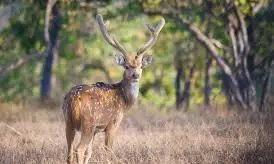MP Tiger Reserve Records Highest Prey Base Density, Study Shows
Survey shows Pench has top ungulate numbers, ensuring strong prey for big cats.

Bhopal: The Pench Tiger Reserve (PTR) in Madhya Pradesh’s Seoni district has recorded the highest prey base density per sq km in the country, a survey on ungulates in the big cat habitats indicates.
An analysis of the latest report on the ‘Status of Ungulates in Tiger Habitats of India’ indicates that the PTR has the highest density of ungulates, a diverse group of hoofed mammals, per sq km at 94.85, the reserve field director, J Devprasad, said on Monday.
This is a very significant achievement for the tiger reserve, he added.
The PTR however, is placed at different positions in the individual ungulate species density in tiger habitats in the country.
The PTR has the second highest density of sambars per sq km at 9.81 among the tiger habitats in the country after Rajaji National Park in Uttarakhand (12.06).
The reserve has also the second highest density of wild pig per sq km at 12.47, after Pilibhit Tiger Reserve in Uttar Pradesh which has a per sq km density of 13.46 of the animal species.
The PTR also records the second highest density of spotted deer per sq km at 53.97 after Jim Corbett National Park, Uttarakhand (56.72).
The PTR has nilgai density of 15.2 per sq km, the second highest, after Ranthambore Tiger Reserve in Rajasthan (15.74).
As far as the population of Indian bison is concerned, the PTR has the second highest density of wild animals at 3.4 per sq km after the Mudumalai Tiger Reserve in Tamil Nadu (7.45).
The PTR has also the highest biomass per sq km at 9876.25 kg among the tiger habitats in the country.
Kanha National Park in Madhya Pradesh has the second highest biomass per sq km at 8602.15 kg.
The high ungulate density in the PTR suggests that the reserve has enough prey base for the big cats like the tiger and leopard.
“This is a result of massive efforts of conservation by the PTR”, the forest officer said.

